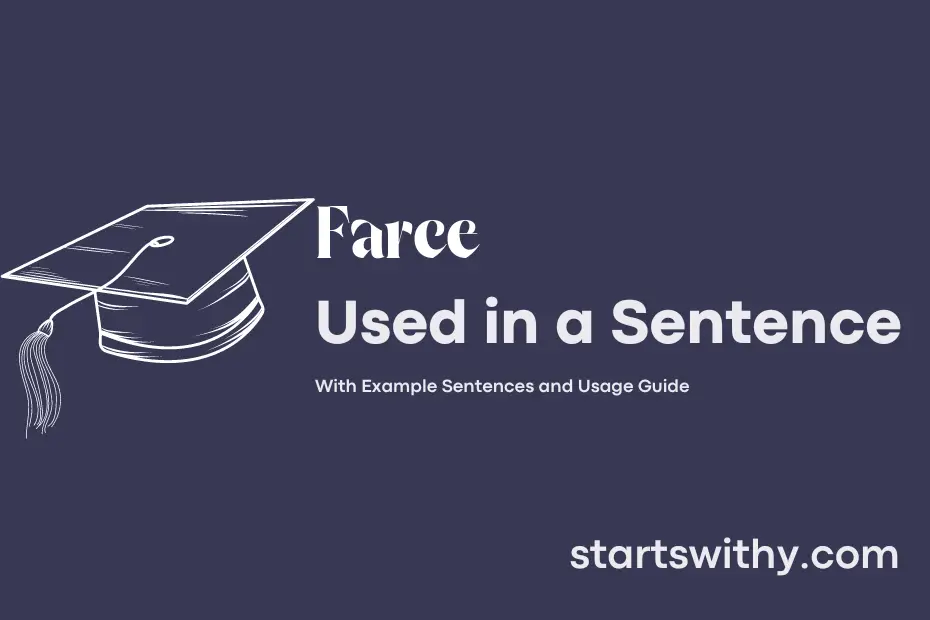Ever wondered what a farce in literature means? A farce is a genre of comedy characterized by improbable situations, exaggerated physical humor, and often ridiculous plot developments. It aims to entertain and provoke laughter through its absurd and far-fetched scenarios.
In a farce, characters often find themselves in increasingly ludicrous predicaments, leading to chaotic and hilarious situations. The humor in a farce is often derived from misunderstandings, mistaken identities, and the characters’ reactions to the absurdity of their circumstances.
7 Examples Of Farce Used In a Sentence For Kids
- The clown’s performance was a funny farce.
- The children at the party acted out a silly farce.
- The magician’s tricks turned out to be a playful farce.
- The puppet show turned into a humorous farce.
- The funny play was full of farce moments.
- The circus act ended in a delightful farce.
- The comedy show had the audience laughing at the farce.
14 Sentences with Farce Examples
- Farce is often used in theatre to create humorous and exaggerated situations.
- The political debates in our college often turn into a farce with students not taking it seriously.
- The college election process was a complete farce with allegations of cheating and unfair practices.
- The student council’s attempt to organize a concert turned into a farce when the band didn’t show up.
- Farce can be a way to address serious issues in a light-hearted manner, making it easier for students to engage with the topic.
- The professor’s attempt to make a serious lecture fun and engaging turned into a farce when his jokes fell flat.
- The college play was supposed to be a drama, but it turned into a hilarious farce due to the actors’ improv skills.
- The college canteen’s attempt to introduce a new menu item became a farce when no one liked the dish.
- The debate competition turned into a farce when one of the teams resorted to personal attacks.
- The college festival’s fashion show turned into a comedic farce when a model accidentally tripped on the runway.
- The attempt to organize a peaceful protest on campus turned into a farce when it descended into chaos.
- The college prank war escalated into a farce when someone accidentally set off the fire alarm.
- The group project quickly turned into a farce when one member didn’t do their share of the work.
- The college’s attempt to host a serious academic conference turned into a farce when the keynote speaker got the date wrong.
How To Use Farce in Sentences?
To use Farce in a sentence, it’s important to know that Farce is a noun that refers to a type of comedy that involves exaggerated and improbable situations, often with ridiculous or slapstick elements.
Here is a simple guide on how to use Farce in a sentence:
-
Identify the context: Before using Farce in a sentence, think about a situation that is funny, exaggerated, or involves absurdity.
-
Select the appropriate words: Choose words that accurately describe the scenario you want to convey.
-
Place “Farce” appropriately in your sentence: Insert Farce in a position that makes the most sense within the sentence. For example, “The play was a delightful farce filled with mistaken identities and hilarious misunderstandings.”
-
Use proper punctuation: Make sure to punctuate your sentence correctly to enhance clarity and readability.
-
Proofread your sentence: After composing your sentence with Farce, read it over to ensure it conveys the intended meaning effectively.
By following these steps, you will be able to incorporate Farce seamlessly into your writing or conversation. Experiment with different contexts and scenarios to fully grasp the comedic essence of this word.
Conclusion
In conclusion, the use of farce in literature, theater, and everyday communication adds humor and entertainment by exaggerating situations or actions to create an absurd or ridiculous tone. Farce often involves improbable scenarios, witty dialogue, and slapstick humor to entertain the audience. Whether it’s in a comedic play, a humorous story, or even casual conversation, farce serves as a comedic device to highlight the absurdities of human behavior and societal norms.
Through the use of farcical elements, writers and speakers can engage audiences by bringing attention to the humorous aspects of life. By employing exaggerated situations, ludicrous antics, and comedic timing, farce creates amusement, laughter, and an escape from the seriousness of reality. Ultimately, farce serves as a valuable tool in crafting entertaining narratives and fostering connections through shared laughter and enjoyment.



